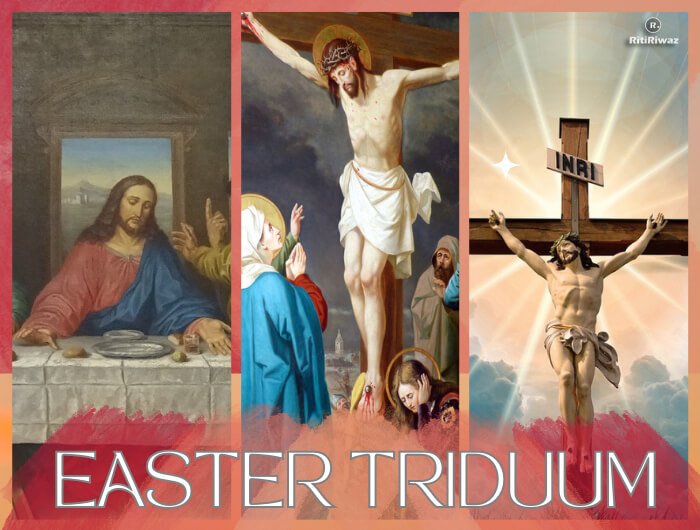Easter Triduum

Easter Triduum, the Sacred Triduum, Paschal Triduum or Holy Triduum is three days that begins on the evening of Holy Thursday and concludes with Easter Sunday. The celebration of the Triduum marks the end of the Lenten season and leads to the Mass of the Resurrection of the Lord at the Easter Vigil.
Sundown on Holy Thursday to sundown on Easter Sunday is considered the most solemn part of the liturgical year. The Triduum “reaches its high point in the Easter Vigil, and closes with evening prayer on Easter Sunday”. In 2023 Easter Triduum will be celebrated between Thursday, April 6th, and Sunday, April 9th.
The word “triduum” comes from the Latin word triduum, which comes from tris (“three”) + dies (“day”). The Sacred Triduum is one great festival recounting the last three days of Jesus’ life on earth, the events of His Passion and Resurrection, and when the Lamb of God laid down his life in atonement for our sins.
So while we might be tempted to say, ‘hey, that’s four days,’ it is only three. It is part of Holy Thursday, the 24 hours of Good Friday, the 24 hours of Holy Saturday, and the part of Easter Sunday.
Lent exists so that we can prepare ourselves for these three great days. What is remembered during these three days is so spectacular and miraculous that it takes the Church fifty days to celebrate it. From the close of Easter Sunday until Pentecost we celebrate with great joy that which Jesus has done for us.
The First Day: Holy Thursday
Holy Thursday begins the Easter Triduum–the three days leading up to Jesus’ Resurrection. Its formal name is Mass of the Lord’s Supper, which was the first celebration of the Eucharist. Other branches of Christianity refer to this day as Maundy Thursday. On Holy Thursday, we remember, we give thanks and praise, and we renew the covenant of love. At that last meal, although he knew that death was on the horizon, he knew that Judas was to betray him, and although he knew that the disciples would desert him, his concern was not for himself, but for his friends.
On the evening of Holy Thursday, as we enter the Easter Triduum.
The Second Day: Good Friday
Good Friday is a mandatory day of fasting and abstinence. This is the day of the crucifixion—the day Jesus died for the sins of the world. He was crucified by the Romans on a hill outside Jerusalem although he had not done anything wrong.
After the last supper, Jesus was arrested in the Garden of Gethsemane, put on trial, and sentenced to death. He was then tied and nailed by the wrists and feet to a large wooden cross and left to die. This is why the cross is used as a symbol of the Christian faith.
Good Friday is a day of mourning. The ceremony on Good Friday is not a Mass—it is a Communion Service using the consecrated hosts from Holy Thursday. Good Friday is the only day of the year on which no Masses are offered. Even after the forty-day Lent became universal, some Christians observed Good Friday fasts with added rigor.
Good Friday is the day of penance, fasting, and prayer.
The Third Day: Holy Saturday
Holy Saturday in the early church concluded with an all-night Easter Vigil. Holy Saturday remembers the day which Jesus spent in the grave resting. It is the day of silence; a silence lived by the first disciples in mourning and bewilderment.
A vigil Mass is held after nightfall on Holy Saturday, or before dawn on Easter Sunday, in celebration of the resurrection of Jesus. This is called the Easter Vigil: the most glorious, beautiful, and dramatic liturgy for the Church.






